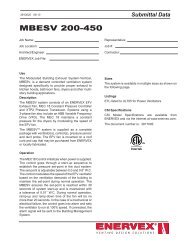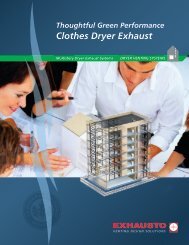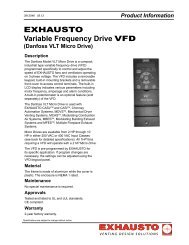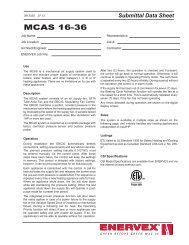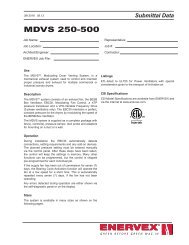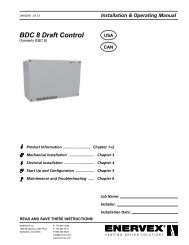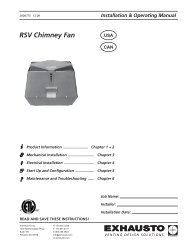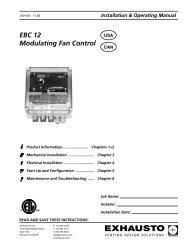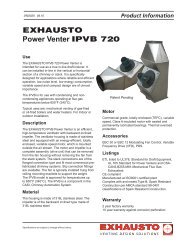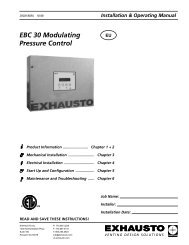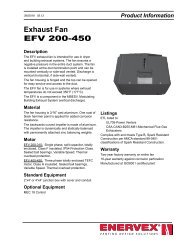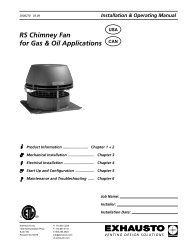Boilers & Water Heaters - Enervex
Boilers & Water Heaters - Enervex
Boilers & Water Heaters - Enervex
Create successful ePaper yourself
Turn your PDF publications into a flip-book with our unique Google optimized e-Paper software.
Demand-Controlled Exhaust Systems for<br />
<strong>Boilers</strong> & <strong>Water</strong> <strong>Heaters</strong><br />
TRUE GREEN SAVINGS<br />
EXHAUSTO Inc.<br />
1200 Northmeadow Pkwy.<br />
Suite 180<br />
Roswell, GA 30076<br />
USA<br />
P: 312.863.9538<br />
F: 312.277.7577<br />
T: 800.255.2923<br />
info@exhausto.com<br />
us.exhausto.com<br />
EXHAUSTO Inc. P: 312.863.9538
EXHAUSTO Makes it Easy and<br />
Economical to be Green<br />
If the exhaust system for a heating appliance (boiler or water<br />
heaters) does not provide a precise draft for the combustion,<br />
it causes the appliance to run inefficiently. An inefficient boiler<br />
is not only more expensive to run, but it emits a higher level of<br />
emissions.<br />
EXHAUSTO’s demand-controlled exhaust system is designed to<br />
optimize the operation of a heating system by maintaining a<br />
precise ration of fuel to air, which relies on proper air supply<br />
and chimney draft.<br />
AIR<br />
A Design That Fits Every<br />
Type of Building<br />
Hotels/Resorts<br />
Offices<br />
Hospitals<br />
Sports Arenas<br />
Schools/Colleges<br />
Museums<br />
Apartments/<br />
Condominiums<br />
With their air louvers and vent terminations, traditional heating<br />
appliance exhaust systems can take up a considerable amount<br />
of space, which impacts a building’s aesthetics. Also, some<br />
buildings are constructed in such a way that an optimal venting<br />
system seems impossible to install.<br />
EXHAUSTO’s demand-controlled exhaust system offers a<br />
flexibility that other system can’t. Not only does it take up much<br />
less space, but because it’s not a gravity-based system, it allows<br />
the engineers to place the boilers where they are best suited.<br />
2<br />
EXHAUSTO Inc.<br />
1200 Northmeadow Pkwy.<br />
P: 312.863.9538<br />
F: 312.277.7577
How Demand-Controlled Exhaust Works<br />
In order to operate efficiently, a boiler must maximize heat<br />
transfer by maintaining the precise ratio of fuel to air, which<br />
relies on proper air supply and draft. Because many factors<br />
affect the draft, including the boiler operation and outdoor<br />
temperatures and elements, maintaining the appropriate level<br />
can be difficult. Too much or too little draft can cause flame<br />
roll-outs or pilot light failures, as well as freezing pipes or<br />
drains in cold climates.<br />
A demand-controlled exhaust system maintains a precise<br />
draft by constantly adjusting the exhaust rate to meet current<br />
demands. The following illustration describes the components<br />
and operation of a demand-controlled exhaust system:<br />
The variable speed<br />
draft fan features a<br />
low-profile design<br />
that is easily accessible.<br />
The constant pressure<br />
controller provides the<br />
power supply.<br />
The main stack can be<br />
straight up or have off-sets,<br />
or it could run horizontally<br />
out through a side wall.<br />
The pressure-differential sensor<br />
monitors pressure inside the main<br />
stack through a duct probe. It is<br />
powered by the controller and<br />
provides the control signal to the<br />
controller. It can be installed in<br />
other locations depending on the<br />
application.<br />
The constant pressure<br />
controller modulates the<br />
speed of the single-phase or<br />
three-phase draft fan. It is<br />
for indoor installation only.<br />
Inline draft fans or overdraft<br />
dampers are usually installed<br />
in this location, before the<br />
exhaust enters the common<br />
vertical, but it can also be<br />
installed in the common<br />
vertical above the tee.<br />
Balancing baffles are often<br />
used to balance the draft<br />
between the appliances.<br />
The exhaust source is a<br />
heating appliance, which<br />
can be condensing or noncondensing<br />
and can be a<br />
gravity-draft or a forceddraft<br />
design.<br />
Proper Draft is Crucial<br />
Improper draft has a major impact on boiler operation. It’s not<br />
uncommon to see high-efficiency boilers operating at low-efficiency<br />
levels. This is a result of inadequate draft control. A boiler’s draft<br />
range is often very narrow and draft control can be made difficult<br />
when multiple boilers are exhausted through a common chimney.<br />
Insufficient<br />
draft<br />
Perfect<br />
draft<br />
Excessive<br />
draft<br />
EXHAUSTO Inc.<br />
1200 Northmeadow Pkwy.<br />
Suite 180<br />
Roswell, GA 30076<br />
USA<br />
3<br />
P: 312.863.9538<br />
F: 312.277.7577<br />
T: 800.255.2923<br />
info@exhausto.com<br />
us.exhausto.com
Sustainable Advantages<br />
Economical<br />
Energy Savings<br />
EXHAUSTO Demand-Controlled<br />
Fan Cost Venting Material Space Cost Fan Operating Cost<br />
17,000 47,000 23,000 4,000<br />
$ Fuel Cost<br />
Multiple 250HP boilers<br />
520,200<br />
per boiler<br />
499,200<br />
per boiler<br />
Combined chimney w/o fan<br />
Venting Material Space Cost Cost of efficiency loss<br />
ECONOMICAL 68,000 40,000 75,000<br />
Multiple 250HP boilers - 4,000 hours/year - $1.20/Therm<br />
Life Cycle Cost (LLC) - 15 years, $1.20/Therm<br />
Multiple <strong>Boilers</strong> with EXHAUSTO<br />
415,000 Therms = $499,200 per boiler<br />
Over a 15-year period a typical demandcontrolled<br />
Multiple boilers exhaust using common system stackserving 4 highefficiency<br />
434,000 Therms boilers = $520,800 in a per 20-story boiler building<br />
costs 50% less to operate than a combined<br />
system ENERGY without SAVINGS demand-control. Most of<br />
these savings are energy savings due to<br />
Multiple 250HP boilers - 4,000 hours/year - $1.20/Therm<br />
boiler efficiency improvements.<br />
$ 1,20 / Therm<br />
Common stack<br />
EXHAUSTO<br />
Hours/Year<br />
4000<br />
Multiple boilers using a common chimney<br />
operate at higher O 2 levels than when<br />
exhausted by individual chimneys.<br />
A mechanical draft system provides more<br />
precise draft control so the O 2 levels can<br />
be lowered. Annual savings can amount to<br />
2-4% and thousands of Dollars.<br />
Multiple <strong>Boilers</strong> with EXHAUSTO<br />
415,000 Therms = $499,200 per boiler<br />
Material and<br />
Labor Savings<br />
Multiple boilers using common stack<br />
434,000 Therms = $520,800 per boiler<br />
Unmatched<br />
Performance<br />
MATERIAL AND LABOR<br />
Venting of 4 high-efficiency boilers in 20-story building<br />
Combined sidewall<br />
venting with EXHAUSTO $27,500<br />
1.0<br />
0.8<br />
Pressure (inWC) EXHAUSTO Other<br />
Combined Venting with EXHAUSTO<br />
Combined Venting<br />
$68,000<br />
$68,000<br />
0.6<br />
0.4<br />
0.2<br />
Individual Venting $87,000<br />
20 40 60 80 100 120 140 160 180 200 220 240 260 280<br />
Seconds<br />
ECONOMICAL<br />
Combining chimneys and reducing dia meters<br />
Life Cycle Cost (LLC) - 15 years, $1.20/Therm<br />
can save material and labor when using a<br />
mechanical draft system. Smaller chimneys<br />
are less expensive to install. Side wall exhaust<br />
can save even more material and labor.<br />
Fan Cost Venting Material Space Cost Fan Operating Cost<br />
17,000 47,000 23,000 4,000 EXHAUSTO Demand-Controlled<br />
Venting Material Space Cost Cost of efficiency loss<br />
68,000 40,000 75,000<br />
Not only is the EXHAUSTO system<br />
fast in response to demand changes,<br />
it’s also able to maintain a +/-2% accuracy<br />
from set-point. Alternative solutions using<br />
a VFD and a pressure sensor only achieve<br />
a +/- 20% accuracy, so their savings are<br />
over 20% less than that of an EXHAUSTO<br />
Combined chimney w/o fan<br />
system.<br />
4
Space Saving<br />
Combining chimneys and reducing diameters can save building space. A smaller footprint<br />
could save as much as $15,000 worth of space in a 20-story building. It also reduces clutter<br />
on the roof. Even more space can be saved if redirecting the chimney out through a sidewall.<br />
Aesthetics<br />
Today’s buildings are designed to be both functional and attractive. While the EXHAUSTO<br />
system provide great space savings, it can also keep chimney terminations out of sight.<br />
The same applies for combustion air supply where large outside gravity louvers or intakes can<br />
be replaced with small louvers when the combustion air supply is provided by an<br />
EXHAUSTO demand-controlled air supply system.<br />
EXHAUSTO Inc.<br />
1200 Northmeadow Pkwy.<br />
Suite 180<br />
Roswell, GA 30076<br />
USA<br />
5<br />
P: 312.863.9538<br />
F: 312.277.7577<br />
T: 800.255.2923<br />
info@exhausto.com<br />
us.exhausto.com
Chimney Automation System<br />
(CASV)<br />
L E E D<br />
EA, MR,<br />
EQ, ID<br />
QUALIFIED<br />
EXHAUSTO SUSTAINABLE DESIGN<br />
Application<br />
The Chimney Automation System (CASV) is a demandcontrolled<br />
exhaust system designed for commercial<br />
boilers and water heaters in buildings where the<br />
exhaust is powered by a chimney fan on<br />
the exterior of the building.<br />
The CASV system can<br />
be combined with a<br />
Modulating Combustion<br />
Air-supply System that<br />
provides combustion air<br />
to a mechanical room.<br />
A common EBC30 can<br />
control both systems<br />
independently.<br />
The products of combustion<br />
are exhausted to the outdoors<br />
by a termination fan. The fan<br />
can be installed below the<br />
parapet for aesthetics.<br />
The common vertical<br />
stack is typically located<br />
inside a fire-rated chase.<br />
The CASV system is<br />
designed to work with<br />
almost any type of heating<br />
appliance fueled by gas<br />
or oil.<br />
The EBC30 constant pressure<br />
controller is located inside<br />
the boiler room close to<br />
the boilers, which are interlocked<br />
with the controller.<br />
The forced-air louver, located<br />
on the building envelope, is<br />
substantially smaller than a<br />
gravity louver.<br />
The air supply fan, which can<br />
be controlled by the EBC30<br />
constant pressure controller,<br />
supplies combustion air at a<br />
demand-controlled rate.<br />
The end of the common<br />
manifold is often the<br />
optimal location of the<br />
probe and transducer.<br />
Complete Code Compliance<br />
EXHAUSTO’s demand-controlled exhaust systems comply with<br />
all national building codes and standards. In most cases a noncompliant<br />
venting installation can be brought into compliance<br />
by the addition of a mechanical draft system.<br />
6
Chimney Automation System<br />
(CASI)<br />
L E E D<br />
EA, MR,<br />
EQ, ID<br />
QUALIFIED<br />
EXHAUSTO SUSTAINABLE DESIGN<br />
Application<br />
The Chimney Automation System (CASI) is a demandcontrolled<br />
exhaust system designed for commercial<br />
boilers and water heaters in buildings where the exhaust is<br />
powered by a fan in the boiler room. This system<br />
is an option for tall buildings or a building that<br />
features sidewall ventilation.<br />
The CASI system can<br />
be combined with a<br />
Modulating Combustion<br />
Air-supply System that<br />
provides combustion air<br />
to a mechanical room.<br />
A common EBC30 can<br />
control both systems<br />
independently.<br />
When an inline draft fan<br />
is used the chimney is<br />
often terminated with a<br />
stack cap.<br />
The common vertical stack<br />
is typically located inside a<br />
fire-rated chase.<br />
The common vertical<br />
stack must be pressure<br />
tight when an inline<br />
draft fan is used.<br />
The CASV system is designed<br />
to work with virtually any<br />
type of heating appliance<br />
fueled by gas or oil.<br />
The EBC30 constant pressure<br />
controller is located inside<br />
the boiler room close to<br />
the boilers, which are interlocked<br />
with the controller.<br />
Exhaust is ventilated to<br />
the outdoors by an inline<br />
fan installed in the boiler<br />
room.<br />
The forced air louver, located<br />
on the building envelope, is<br />
substantially smaller than a<br />
gravity louver.<br />
The air supply fan supplies combustion<br />
air at a demand-controlled rate.<br />
The fan can be controlled by the<br />
EBC30 constant pressure controller.<br />
Add Value to the Building<br />
An EXHAUSTO system can add real value to a building.<br />
Through the energy savings generated via the improved boiler<br />
operating efficiency value is added by lowering the utility bill.<br />
Added value can be as much as six times the annual energy<br />
savings. Boiler maintenance cost is reduced while extending<br />
equipment life expectancy.<br />
EXHAUSTO Inc.<br />
1200 Northmeadow Pkwy.<br />
Suite 180<br />
Roswell, GA 30076<br />
USA<br />
7<br />
P: 312.863.9538<br />
F: 312.277.7577<br />
T: 800.255.2923<br />
info@exhausto.com<br />
us.exhausto.com
Modulating Over-Draft<br />
Damper<br />
L E E D<br />
EA, MR,<br />
EQ, ID<br />
QUALIFIED<br />
EXHAUSTO SUSTAINABLE DESIGN<br />
Application<br />
The Modulating Over-Draft System (MODS) is a demandcontrolled<br />
exhaust system that’s designed for buildings that<br />
experience excessive draft in the chimney, which<br />
impacts the ability of the heating system to<br />
operate efficiently.<br />
The MODS system can<br />
be combined with a<br />
CASV or CASI Chimney<br />
Automation System<br />
or/and a MCAS Modulating<br />
Combustion<br />
Air-supply System that<br />
provides combustion<br />
air to a mechanical<br />
room.<br />
Exhaust is ventilated to the outdoors<br />
with or without a draft fan. The fan<br />
may be needed for multiple boiler<br />
applications and can be installed<br />
below the parapet for aesthetics.<br />
The common vertical<br />
stack is typically located<br />
inside a fire-rated chase.<br />
The EBC30 constant pressure<br />
controller is interlocked with<br />
the boilers and is located<br />
close to them inside the<br />
boiler room.<br />
The MODS system is<br />
designed to work with<br />
almost any type of heating<br />
appliance fueled by<br />
gas or oil, but it’s mostly<br />
used with forced-draft<br />
type of boilers.<br />
The forced-air louver,<br />
located on the building<br />
envelope, is substantially<br />
smaller than a gravity<br />
louver.<br />
The air supply fan, which can<br />
be controlled by the EBC30<br />
constant pressure controller,<br />
supplies combustion air at a<br />
demand-controlled rate.<br />
The end of the common<br />
manifold is often the<br />
optimal location of the<br />
probe and transducer.<br />
The modulating multiblade<br />
damper is located<br />
in the horizontal manifold<br />
between the boiler<br />
and the vertical chimney.<br />
It is powered and controlled<br />
by the EBC 30.<br />
Eliminate Large Air Louvers<br />
Combustion air supply louvers require a large amount of<br />
wall space and can compromise the aesthetics of a building.<br />
Although it may be impossible to eliminate them, a mechanical<br />
air supply system can reduce the louver size dramatically. This<br />
can also eliminate the risk for frozen water pipes and drains in<br />
cold climates.<br />
8
EXHAUSTO Success Stories<br />
Georgia Aquarium<br />
The Georgia Aquarium, which opened in November of 2005, is one of<br />
the largest aquariums in the world, featuring more than 55,000 fish<br />
from approximately 500 species and an estimated 8 million gallons of<br />
fresh and saltwater. With a project of this magnitude, it’s critical that<br />
the boiler system that heats the water operates efficiently with the<br />
appropriate ventilation. To ensure this, the developers opted to install<br />
a demand-controlled EXHAUSTO<br />
mechanical draft system. Because<br />
the boiler system is located under<br />
the parking structure, the fans are<br />
installed in an enclosed casing,<br />
out of sight, on the top of the<br />
parking building.<br />
Heinz Stadium<br />
Venting the heating appliances at a sports facility is always a challenge,<br />
as was the case with Heinz Field in Pittsburgh, PA. The stadium featured<br />
a field heating system and domestic water heaters, which ran both<br />
horizontally and vertically, along with many elbows.<br />
EXHAUSTO’s venting system included a demand controlled mechanical<br />
draft system. The eight Thermal Solution EVH-2000 boilers are vented<br />
with a EXHAUSTO CASV demand-controlled mechanical draft system.<br />
The domestic water heating system is using a venting system that includes<br />
a CASV450-2 demand controlled<br />
mechanical draft system. The system<br />
controls the draft of the two A.O.<br />
Smith 4,000MBH domestic water<br />
heaters. In addition, two water<br />
heaters on the concourse levels are<br />
vented with two CASV demand<br />
controlled mechanical draft systems.<br />
Orange County Center of Performing Arts<br />
In 2006, The Orange County Performing Arts Center expanded its venues<br />
to include the 2,000-seat Renée and Henry Segerstrom Concert Hall and<br />
500-seat multi-functional Samueli Theater. With its beautiful design, the<br />
last thing this high-profile building needed was a boiler exhaust system<br />
ruining aesthetics.<br />
The heating system consisted of six Cleaver-Brooks boilers along with two<br />
A.O. Smith water heaters. EXHAUSTO designed a single exhaust stack<br />
system that integrated a demand-controlled mechanical draft system along<br />
with modulating draft dampers<br />
to assure perfect boiler operation<br />
conditions at all times. The boilers<br />
now take up a minimum amount of<br />
floor space and the mechanical draft<br />
fans allow for a stack termination to<br />
be installed out of sight below the<br />
parapet wall.<br />
EXHAUSTO Inc.<br />
1200 Northmeadow Pkwy.<br />
Suite 180<br />
Roswell, GA 30076<br />
USA<br />
9<br />
P: 312.863.9538<br />
F: 312.277.7577<br />
T: 800.255.2923<br />
info@exhausto.com<br />
us.exhausto.com
All the Right Components<br />
RSV Chimney Fan<br />
<br />
• Rugged and compact design<br />
• High-efficiency aluminum centrifugal impeller<br />
• Made in cast aluminum for outdoor installation<br />
• Variable speed, direct drive, TEFC motor<br />
• 5 sizes available, ETL and ETLc listed to UL378<br />
EXSTREAM<br />
P E R F O R M A N C E<br />
D EVELOPED AND MANUFACTURED BY EXHAUSTO<br />
RSV200 RSV250 RSV315 RSV400 RSV450<br />
Power Supply VAC 1x120 3x208-240 / 3x380-400<br />
Amperage Amp 1.4 2.9 5.8 3.5 / 2.1 6.5 / 3.8<br />
Motor Output HP (kW) 0.15 (0.1) 0.2 (0.16) 0.5 (0.35) 1.0 (0.75) 2.0 (1.5)<br />
RPM 1600 1720<br />
Weight Lbs (kg) 47 (18) 60 (26) 88 (35) 97 (44) 128 (58)<br />
Duct Connections Inch (mm) 8 (200) 10 (250) 12 (315) 16 (400) 16 (400)<br />
Max Capacity CFM 500 1,150 2,000 2,900 3,900<br />
RSIB Power Venter<br />
• Inline exhaust in compact design<br />
• High-efficiency aluminum centrifugal impeller<br />
• Made in 316SS for indoor and outdoor installation<br />
• Variable speed, direct drive, TEFC motor<br />
• 4 sizes available, ETL and ETLc listed to UL378<br />
EXSTREAM<br />
P E R F O R M A N C E<br />
D EVELOPED AND MANUFACTURED BY EXHAUSTO<br />
RSIB300 RSIB300 RSIB 350 RSIB 400 RSIB 500<br />
Power Supply VAC 1x120 1x220-240 3x200-240 / 3x400-480<br />
Amperage Amp 5.8 2.9 3.1 / 1.7 6.5 / 2.9 9.0 / 4.0<br />
Motor Output HP (kW) 0.5 (0.35) 0.5 (0.35) 1.0 (0.75) 2.0 (1.5) 3.0 (2.25)<br />
RPM 1600 1400 1720 1720 1720<br />
Weight Lbs (kg) 70 (32) 70 (32) 84 (38) 132 (60) 170 (77)<br />
Duct Connections Inch (mm) 12 (300) 12 (300) 16 (400) 16 (400) 20 (500)<br />
Max Capacity CFM 1,500 1,200 2,400 4,300 5,800<br />
BESB Low Energy Supply Fan<br />
• Low energy fan in compact design<br />
• High-efficiency aluminum centrifugal impeller<br />
• Made in corrosion resistant material for indoor and outdoor installation<br />
• Variable speed, direct drive, TEFC motor<br />
• 4 sizes available, ETL and ETLc listed to UL705<br />
EXSTREAM<br />
P E R F O R M A N C E<br />
D EVELOPED AND MANUFACTURED BY EXHAUSTO<br />
BESB250 BESB250 BESB315 BESB400 BESB500<br />
Power Supply VAC 1x120 1x220-240 3x200-240 / 3x400-480<br />
Amperage Amp 5.8 2.9 3.1 / 1.7 6.5 / 2.9 9.0 / 4.0<br />
Motor Output HP (kW) 0.5 (0.35) 0.5 (0.35) 1.0 (0.75) 2.0 (1.5) 3.0 (2.25)<br />
RPM 1600 1400 1720 1720 1720<br />
Weight Lbs (kg) 70 (32) 70 (32) 84 (38) 132 (60) 170 (77)<br />
Duct Connections Inch (mm) 12 (300) 12 (300) 16 (400) 16 (400) 20 (500)<br />
Max Capacity CFM 1,500 1,200 2,400 4,300 5,800<br />
10
SFTA Supply Fan<br />
• Tubeaxial fan in compact design<br />
• Steel housing and cast aluminum propeller<br />
• Variable speed, direct drive, TEFC motor<br />
• 6 sizes available, ETL and ETLc listed to UL705<br />
SFTA 16 SFTA18 SFTA21 SFTA24 SFTA30 SFTA36<br />
Power Supply VAC 3x200-240 OR 3x440-480<br />
Amperage Amp 2.8 / 1.4 2.8 /1.4 4.0 / 2.0 8.2 / 4.1 14.2 / 7.1 23.0 / 11.5<br />
Motor Output HP (kW) 1.0 (0.75) 1.0 (0.75) 1.5 (1.3) 3.0 (2.25) 5.0 (3.75) 10.0 (7.5)<br />
RPM 1750<br />
Weight Lbs (kg) 53 (24) 60 (27) 85 (39) 97 (54) 149 (77) 234 (117)<br />
Duct Connections Inch (mm) 16 (400) 18 (450) 21 (530) 24 (600) 30 (750) 36 (910)<br />
Max Capacity CFM 4,000 5,000 7,000 11,000 17,000 31,000<br />
EBC Fan Speed Control<br />
• Constant pressure fan speed controller for fan or ventilator<br />
• Used with single, modulating heating appliance<br />
• Provides 0-10V or 10-120V signal<br />
• ETL and ETLc listed<br />
Power Supply VAC (Hz) 1x120 (60Hz) / 1x240 (50-60Hz)<br />
Amperage Amp 6.3 / 3.15<br />
Operating Temperature °F (°C) -4 to 104 (-20 to 50)<br />
Range of Operation In WC (Pa) 0-0.6 (0-150)<br />
Output VAC 10-120 / 20-240<br />
VDC 0-10<br />
Weight Lbs (kg) 3.0 (1.5)<br />
MicroVLT Variable Frequency Drive<br />
• Variable speed drive for use with 3-phase fans and power venters<br />
• Pre-programmed from factory – no field programming needed<br />
• Available for 200-240VAC and 400-480VAC<br />
MDF Modulating Damper Control<br />
• Multiblade damper in 304 stainless steel (316SS available)<br />
• Stainless steel shaft and bearings<br />
• Fast-acting damper motor with brushless DC motor<br />
• Operating temperatures up to 750°F (400°C)<br />
• Equipped with EnerDrive failsafe system<br />
• 16 sizes available<br />
EXHAUSTO Inc.<br />
1200 Northmeadow Pkwy.<br />
Suite 180<br />
Roswell, GA 30076<br />
USA<br />
11<br />
P: 312.863.9538<br />
F: 312.277.7577<br />
T: 800.255.2923<br />
info@exhausto.com<br />
us.exhausto.com
EXHAUSTO<br />
– Made By Experience<br />
EXHAUSTO combines quality components, superior technology<br />
and experienced personnel to deliver a system that is economical,<br />
environmentally sustainable, aesthetically pleasing and<br />
reliable. In addition, our custom engineering and space saving<br />
design ensure that the project meets code requirements, as<br />
well as the high standards of today’s builders. At EXHAUSTO,<br />
we don’t build a one-size-fits-all venting system. We understand<br />
that each project is unique and our three-step process allows us<br />
to design a venting system that meets the specific requirements<br />
of a given job.<br />
The EXHAUSTO Performance Guarantee<br />
Because EXHAUSTO designs the entire venting system, we<br />
take full responsibility for its operation. Contact EXHAUSTO<br />
for details.<br />
The FanCalc Difference<br />
One of the many things that set EXHAUSTO apart from our<br />
competitors is our proprietary design software, FanCalc.<br />
FanCalc allows our engineers to quickly and accurately design<br />
a venting system because it contains extensive boiler and water<br />
heater data, such as operating and exhaust requirements,<br />
exhaust temperatures, efficiency, ducts with k-values, resistance<br />
factors, insulation factors and more. Instead of spending days or<br />
weeks analyzing data, our engineers can enter the information<br />
into FanCalc and receive a report that provides the appropriate<br />
sizing information, code violation warnings and even design<br />
alternatives.<br />
The EXHAUSTO Process<br />
1. Pre-sales analysis<br />
This phase allows us to gather requirements<br />
and create a customized sizing<br />
report.<br />
2. System design<br />
Using our FanCalc software, our<br />
engineers design a system that takes<br />
into consideration proper vent type<br />
application, operating temperatures,<br />
pressure losses and the risk of condensation.<br />
It also provides specific wiring<br />
diagrams.<br />
EXHAUSTO and LEED<br />
3. Engineering and installation<br />
support<br />
Every EXHAUSTO system comes<br />
complete with job-specific AutoCAD<br />
installation instructions and wiring<br />
diagrams. Our engineering support<br />
teams have access to these files and<br />
are available to answer any questions<br />
that come up during installation.<br />
EXHAUSTO’s systems qualify for LEED points under the Energy & Atmosphere (EA),<br />
Materials & Resources (MR), Indoor Environmental Quality (EQ) and Innovation &<br />
Design Process (ID) sections. EXHAUSTO has actively promoted low-energy installations,<br />
energy savings, indoor air quality and recycling for decades – long before it became<br />
“in”. For years EXHAUSTO has been involved in the European legislation processes and<br />
has been a member of United States Green Building Council (USGBC) since 2005.<br />
Unlike most manufacturers we didn’t have to come up with ”new” GREEN solutions<br />
– we have made them for decades!<br />
3911006 05.09<br />
EXHAUSTO EXHAUSTO Inc. Inc.<br />
P: 770.587.3238 P: 312.863.9538<br />
1200 Northmeadow 1200 Northmeadow Pkwy. Pkwy. F: 770.587.4731 F: 312.277.7577<br />
Suite 180<br />
T: 800.255.2923<br />
Roswell, GA<br />
Suite<br />
30076<br />
180<br />
info@exhausto.com<br />
T: 800.255.2923<br />
USA Roswell, GA 30076 us.exhausto.com info@exhausto.com<br />
USA<br />
us.exhausto.com



